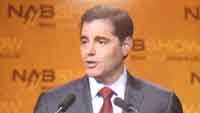FCC chairman addresses broadband plan ‘myths,’ extends hand to broadcasters

FCC Chairman Julius Genachowski called on TV broadcasters to ignore what he described as hyperbole surrounding hotly debated portions of the commission’s National Broadband Plan spelling out how the agency will recoup 120MHz of TV broadcast spectrum and to carefully consider the benefits of participating.
The chairman told the broadcasters assembled April 13 in Las Vegas for his keynote speech during the 2010 NAB Show that specific measures described in the plan, including voluntary incentive auctions, which would reward participating TV broadcasters surrendering spectrum with a portion of the proceeds from the auctioning of that spectrum, and spectrum sharing, can help to alleviate projected spectrum shortages created by burgeoning demand for smart phones and wireless Internet usage.
“We are in the midst of a transformative digital age, and having a world-leading broadband infrastructure is a vital part of our national strategy to compete globally and have an enduring engine of job creation and economic growth in the 21st Century,” Genachowski said during his speech. The chairman cited recent surveys ranking U.S. broadband infrastructure as low as 15 globally for Internet adoption, 18 for speed, and dead last in 2009 among 40 countries studied in the rate of change in innovative capacity.
Saying on its current trajectory, demand for the Internet and mobile phone spectrum will outstrip supply, the chairman told his audience that more than 100 high-tech companies have told the commission in formal filings that “our nation’s ability to lead the world in innovation and technology is threatened by the lack of sufficient spectrum for wireless broadband applications and services.”
“This is not a theory or idle speculation; it’s math and physics,” he said.
Last month the Federal Communications Commission presented its massive National Broadband Plan to Congress. In it, the agency outlined a variety of steps aimed at freeing a total of 500MHz for wireless broadband Internet service, of which 120MHz will come from repacking DTV spectrum. Many broadcasters and some in Congress are wary of what they sense is the carrot-and-stick tone of the spectrum clearing measures outlined. Specifically, they want to know if the commission simply will seize TV spectrum if not enough stations choose to participate in voluntary incentive auctions to meet the plan’s spectrum goals.
“I truly don’t believe it will come to that,” Genachowski said. “Our country can’t afford for it to come to that. I believe that a voluntary auction plan based on unlocking billions of dollars of value and sharing it, a plan that needs the participation and spectrum sharing of a limited number of broadcasters, who will get to lower their operating costs and receive a cash infusion, while continuing on the air, I believe such a plan can and will produce a multilevel win for a series of great American industries, including broadcasting, mobile broadband, consumer electronics, and technology companies.”
Get the TV Tech Newsletter
The professional video industry's #1 source for news, trends and product and tech information. Sign up below.
During his address to broadcasters, Genachowski sought to allay fears and dispel what he described as four myths that have arisen regarding the plan. First, the plan is not designed to confiscate spectrum and drive broadcasters out of business, he said. To the contrary, the incentive auction will be “an economic boost to broadcasters that elect to participate,” he said.
The second myth, Genachowski said, is the plan will reduce the number of voices on-air and diminish diversity and localism. However, giving broadcasters new options and a capital infusion from auction proceeds should “strengthen diversity and bolster the public interest,” he said.
The third incorrect notion is the plan will prevent deployment of mobile DTV, he said. Calling this idea a “misperception,” Genachowski said he was pleased the DTV transition has enabled standards and market trials of the new mobile service. “Our job is not to predict innovation or business models, but to enable them,” he said. The plan will allow broadcasters who retain all 6MHz of their channel as well as those who choose to share to roll out mobile DTV service, he said.
The fourth myth is consumers will have to buy new gear, he said. Not so, said Genachowski. The plan will have no effect on consumers who watch via cable, satellite, or IPTV, and OTA DTV viewers would simply have to rescan their TVs or converter boxes. He added, “And to the extent that the transition would impose any new costs on broadcasters themselves, those costs could be covered by the auction proceeds,” he said.
“I call on broadcasters to ignore the hyperbole and focus on the real challenges and the real opportunities,” he said. “Move beyond inside-the-beltway debates and tactics, consider carefully what the broadband plan actually proposes, accept our offer to work with us constructively on fleshing it out, improving it where appropriate, and finding a real win for the country and all stakeholders.”
Phil Kurz is a contributing editor to TV Tech. He has written about TV and video technology for more than 30 years and served as editor of three leading industry magazines. He earned a Bachelor of Journalism and a Master’s Degree in Journalism from the University of Missouri-Columbia School of Journalism.

